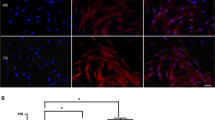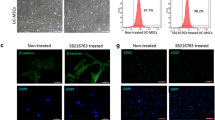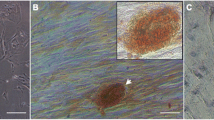Abstract
Cardiotrophin-1 (CT1) plays an important role in the differentiation, development, and survival of neural stem cells. In this study, we analyzed its effects on the stimulation of human umbilical cord blood-derived mesenchymal stem cells in terms of their potential to differentiate into neuron-like cells, their survival characteristics, and the molecular mechanisms involved. The treatment of cells with neural induction medium (NIM) and CT1 generated more cells that were neuron-like and produced stronger expression of neural-lineage markers than cells treated with NIM and without CT1. Bcl-2 and Akt phosphorylation (p-Akt) expression levels increased significantly in cells treated with both NIM and CT1. This treatment also effectively blocked cell death following neural induction and decreased Bax, Bak and cleaved-caspase 3 expression compared with cells treated with NIM without CT1. In addition, the inhibition of phosphatidylinositol 3-kinase (PI3K) abrogated p-Akt and Bcl-2 expression. Thus, PI3K/Akt contribute to CT1-stimulated neural differentiation and to the survival of differentiated cells.





Similar content being viewed by others
References
Bordet T, Lesbordes JC, Rouhani S, Castelnau-Ptakhine L, Schmalbruch H, Haase G, Kahn A (2001) Protective effects of cardiotrophin-1 adenoviral gene transfer on neuromuscular degeneration in transgenic ALS mice. Hum Mol Genet 10:1925–1933
Brazel CY, Alaythan AA, Felling RJ, Calderon F, Levison SW (2014) Molecular features of neural stem cells enable their enrichment using pharmacological inhibitors of survival-promoting kinases. J Neurochem 128:376–390
Burdon TJ, Paul A, Noiseux N, Prakash S, Shum-Tim D (2011) Bonemarrow stem cell derived paracrine factors for regenerative medicine: current perspectives and therapeutic potential. Bone Marrow Res 2011, 207326
Calabro P, Limongelli G, Riegler L, Maddaloni V, Palmieri R, Golia E, Roselli T, Masarone D, Pacileo G, Golino P, Calabro R (2009) Novel insights into the role of cardiotrophin-1 in cardiovascular diseases. J Mol Cell Cardiol 46:142–148
Dolcet X, Soler RM, Gould TW, Egea J, Oppenheim RW, Comella JX (2001) Cytokines promote motoneuron survival through the Jaunus kinase-dependent activation of the phosphatidylinositol 3-kinase pathway. Mol Cell Neurosci 18:619–631
Garcia-Cenador MB, Lopez-Novoa JM, Diez J, Garcia-Criado EJ (2013) Effects and mechanism of organ protection by cardiotrophin-1. Curr Med Chem 20:246–256
Hunt LC, White J (2016) The role of leukemia inhibitory factor receptor signaling in skeletal muscle growth, injury and disease. Adv Exp Med Biol 900:45–59
Kaplan DR, Miller FD (2000) Neurotrophin signal transduction in the nervous system. Curr Opin Neurobiol 10:381–391
Latchman DS (2000) Cardiotrophin-1: a novel cytokine and its effects in the heart and other tissues. Pharmacol Ther 85:29–37
Le Belle JE, Orozco NM, Paucar AA, Saxe JP, Mottahedeh J, Pyle AD, Wu H, Kornblum HI (2011) Proliferative neural stem cells have high endogenous ROS levels that regulate self-renewal and neurogenesis in a PI3K/Akt-dependant manner. Cell Stem Cell 8:59–71
Liu B, Ma A, Zhang F, Wang Y, Li Z, Li Q, Xu Z, Zheng Y (2016) MAZ mediates the cross-talk between CT-1 and NOTCH1 signaling during gliogenesis. Sci Rep 6:21534
Lopez-Yoldi M, Moreno-Aliaga MJ, Bustos M (2015) Cardiotrophin-1: a multifaceted cytokine. Cytokine Growth Factor Rev 26:523–532
Lu P, Blesch A, Tuszynski MH (2004) Induction of bone marrow stromal cells to neurons:differentiation, transdifferentiation, or artifact? J Neurosci Res 77:174–191
Middleton G, Hamanoue M, Enokido Y, Wyatt S, Pennica D, Jaffray E, Hay RT, Davies AM (2000) Cytokine-induced nuclear factor kappa B activation promotes the survival of developing neurons. J Cell Biol 148:325–332
Mitsumoto H, Klinkosz B, Pioro EP, Tsuzaka K, Ishiyama T, O’Leary RM, Pennica D (2001) Effects of cardiotrophin-1(CT-1) in a mouse motor neuron disease. Muscle Nerve 24:769–777
Peng L, Shu X, Lang C, Yu X (2016) Effects of hypoxia on proliferation of human cord blood-derived mesenchymal stem cells. Cytotechnology 68:1615–1622
Pennica D, Shaw KJ, Swanson TA, Moore MW, Shelton DL, Zioncheck KA, Rosenthal A, Taga T, Paoni NF, Wood WI (1995) Cardiotrophin-1 biological activities and binding to the leukemia inhibitory factor receptor/gp130 signaling complex. J Biol Chem 270:10915–10922
Pennica D, Arce V, Swanson TA, Vejsada R, Pollock RA, Armanini M, Dudley K, Phillips HS, Rosenthal A, Kato AC, Henderson CE (1996) Cardiotrophin-1, a cytokine present in embryonic muscle, supports long-term survival of spinal motoneurons. Neuron 17:63–74
Quiros Y, Blanco-Gozalo V, Sanchez-Gallego JI, Lopez-Hernandez FJ, Ruiz J, Perez de Obanos MP, Lopez-Novoa JM (2016) Cardiotrophin-1 therapy prevents gentamicin-induced nephrotoxicity in rats. Pharmacol Res 107:137–146
Sendtner M, Carroll P, Holtmann B, Hughes RA, Thoenen H (1994) Ciliary neurotrophic factor. J Neurobiol 25:1436–1453
Shu X, Du S, Chen X, Li Z (2011) Transplantation of neural stem cells overexpressing cardiotrophin-1 inhibits sprouting of hippocampal mossy fiber in a rat model of status epilepticus. Cell Biochem Biophys 61:367–370
Shu T, Wu T, Pang M, Liu C, Wang X, Wang J, Liu B, Rong L (2016) Effects and mechanisms of melatonin on neural differentiation of induced pluripotent stem cells. Biochem Biophys Res Commun 474:566–571
Thier M, Hall M, Health JK, Pennica D, Weis J (1999) Trophic effects of cardiotrophin-1 and interleukin-11 on rat dorsal root ganglion neurons in vitro. Brain Res Mol Brain Res 64:80–84
Tzeng HH, Hsu CH, Chung TH, Lee WC, Lin CH, Wang WC, Hsiao CY, Leu YW, Wang TH (2015) Cell signaling and differential protein expression in neuronal differentiation of bone marrow mesenchymal stem cells with hypermethylated Salvador/Warts/Hippo (SWH) pathway genes. PLoS ONE 10:e0145542
Urnukhsaikhan E, Cho H, Mishig-Ochir T, Seo YK, Park JK (2015) Plused electromagnetic fields promote survival and neuronal differentiation of human BM-MSCs. Life Sci 151:130–138
Wang D, Li X, Gao K, Lu D, Zhang X, Ma C, Ye F, Zhang L (2013) Cardiotrophin-1 (CTF1) ameliorates glucose-uptake defects and improves memory and learning deficits in a transgenic mouse model of Alzheimer’s disease. Pharmacol Biochem Behav 107:48–57
Yao R, Cooper GM (1995) Requirement for phosphatidylinositol-3 kinase in the prevention of apoptosis by nerve growth factor. Science 267:2003–2006
Yuan J, Yankner BA (2000) Apoptosis in the nervous system. Nature 407:802–809
Acknowledgements
This study was funded by Grants from the National Natural Science Foundation (No. 31260286) of China. We are grateful to doctors and nurses of the Obstetrical Department of Maternity and child health care hospital in Zunyi for the collection of the cord blood.
Author information
Authors and Affiliations
Corresponding author
Rights and permissions
About this article
Cite this article
Peng, L., Shu, X., Lang, C. et al. Cardiotrophin-1 stimulates the neural differentiation of human umbilical cord blood-derived mesenchymal stem cells and survival of differentiated cells through PI3K/Akt-dependent signaling pathways. Cytotechnology 69, 933–941 (2017). https://doi.org/10.1007/s10616-017-0103-6
Received:
Accepted:
Published:
Issue Date:
DOI: https://doi.org/10.1007/s10616-017-0103-6




